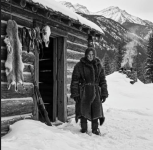The Widow of Elk Creek – A Trapper’s Wife in the Deep Montana Winter
Beartooth Mountains, Montana Territory, 1886–1887
She came west for love.
She stayed alive for spite.
When the snow came early and the grizzlies stayed late —
she loaded the rifle, boiled the bones, and kept the fire going.
The Edge of Civilization
The Beartooth Range was no place for comfort.
It was:
9,000 feet up
Weeks from the nearest town
A place of ice winds, rockslide paths, and silent forests
Trapped between grizzlies, wolves, and starvation
Most who lived there were fur trappers or seasonal hands.
But in 1884, Elizabeth "Elsie" Macklin, age 24, left Kansas to marry a trapper named John who built a two-room cabin at the mouth of Elk Creek.
For two years, they ran traplines and traded pelts for flour, bullets, and coffee beans.
Then in October of 1886, John went upriver to hunt beaver.
He never came back.
Alone Before the Freeze
Elsie waited. A day. Then a week.
By the time she lit out to search, snow had already begun to fall.
She found his pack torn open near a frozen bend.
No body. Just blood.
Just claw marks in the tree bark — ten feet high.
Six Months of Silence
From November to April, Elsie:
Re-set his traplines herself
Boiled pine needles for vitamin C
Shot and butchered a bear that tried to break into the smokehouse
Burned the pages of an old Bible for firestarter
Fixed her snowshoes three times
Patched a frostbite-blackened toe with bear grease and muslin
She spoke aloud only to the wind.
Her dog, Tuck, froze to death in February.
She wrapped him in flannel and buried him under the cabin floor.
Rescue Comes Late
A pair of traders stumbled onto her cabin in late April, expecting it to be abandoned.
Instead, they found:
A woman 20 pounds thinner
With a loaded rifle across her lap
A line of smoked beaver pelts hanging above the stove
And a bear skull nailed to the door with the words “I stayed.”
Legacy
Elsie returned to Kansas that summer.
She never remarried.
She opened a general store, where she sold snares and taught girls how to skin rabbits.
Locals called her “The Elk Widow.”
When she died in 1919, her coffin was lined with fur she’d trapped herself.


 www.facebook.com
www.facebook.com


